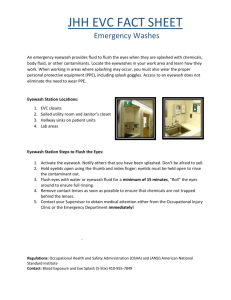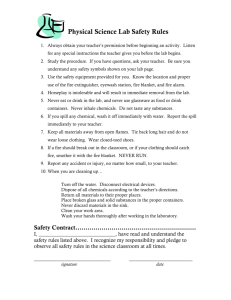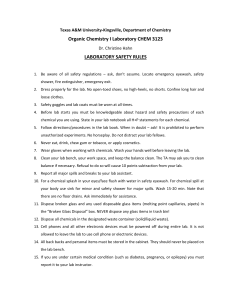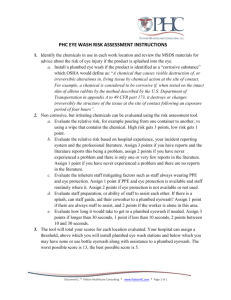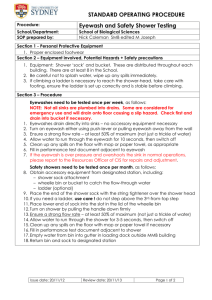EMERGENCY EYE WASH FACILITY POLICY
advertisement
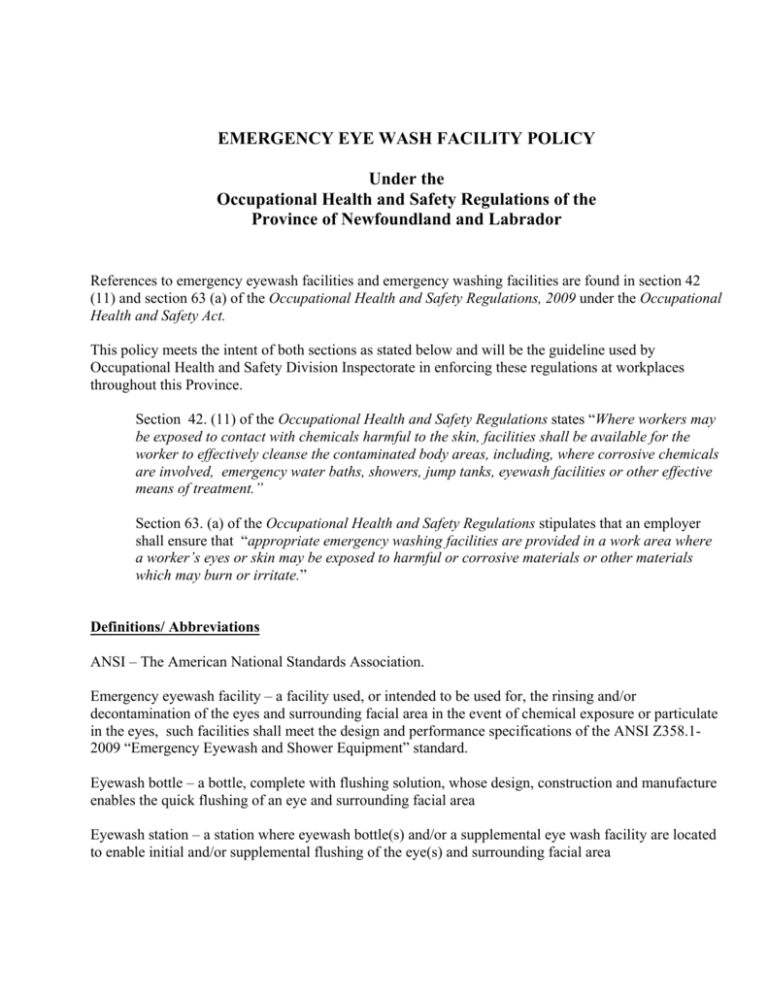
EMERGENCY EYE WASH FACILITY POLICY Under the Occupational Health and Safety Regulations of the Province of Newfoundland and Labrador References to emergency eyewash facilities and emergency washing facilities are found in section 42 (11) and section 63 (a) of the Occupational Health and Safety Regulations, 2009 under the Occupational Health and Safety Act. This policy meets the intent of both sections as stated below and will be the guideline used by Occupational Health and Safety Division Inspectorate in enforcing these regulations at workplaces throughout this Province. Section 42. (11) of the Occupational Health and Safety Regulations states “Where workers may be exposed to contact with chemicals harmful to the skin, facilities shall be available for the worker to effectively cleanse the contaminated body areas, including, where corrosive chemicals are involved, emergency water baths, showers, jump tanks, eyewash facilities or other effective means of treatment.” Section 63. (a) of the Occupational Health and Safety Regulations stipulates that an employer shall ensure that “appropriate emergency washing facilities are provided in a work area where a worker’s eyes or skin may be exposed to harmful or corrosive materials or other materials which may burn or irritate.” Definitions/ Abbreviations ANSI – The American National Standards Association. Emergency eyewash facility – a facility used, or intended to be used for, the rinsing and/or decontamination of the eyes and surrounding facial area in the event of chemical exposure or particulate in the eyes, such facilities shall meet the design and performance specifications of the ANSI Z358.12009 “Emergency Eyewash and Shower Equipment” standard. Eyewash bottle – a bottle, complete with flushing solution, whose design, construction and manufacture enables the quick flushing of an eye and surrounding facial area Eyewash station – a station where eyewash bottle(s) and/or a supplemental eye wash facility are located to enable initial and/or supplemental flushing of the eye(s) and surrounding facial area Supplemental eyewash facility – a plumbed, faucet mounted, and/or self contained device whose design, construction and manufacture enables the quick flushing of both eyes and surrounding facial area, but does not fully meet the design and performance specifications of the ANSI Z358.1-2009 “Emergency Eyewash and Shower Equipment” standard. Requirements To determine the need for emergency eyewash facilities, chemical safety information and/or the material safety data sheet (MSDS) shall be reviewed. If such information indicates, in the first aid section that greater than 15 minutes of continuous flushing is required, in the event of worker face/eye exposure, then emergency eyewash facilities are to be provided and maintained in a state of operational readiness. Chemical safety information and/or the MSDS may also stipulate that needed controls include an emergency eyewash station or facility. Eyewash bottles, as a stand alone resource, do not satisfy the requirement for an emergency eyewash facility. Reasoning includes the inability to flush both eyes simultaneously, the inability to provide 60 minutes of continuous flushing and the inability for a person using a portable eyewash bottle to have both hands free to keep their eyelids open while flushing. Combinations of eyewash bottle(s), safe work procedures and supplemental eyewash facilities, if appropriately designed and implemented, may provide an equivalent level of interim protection to that of an emergency eyewash facility that meets the requirements of this policy. Should an employer choose such an arrangement and need clarification, the Occupational Health Section of the Occupational Health and Safety Division should be contacted. Location Should an emergency eyewash facility be required, it shall be installed within a maximum of 50 feet/15.24 m of linear travel, or within approximately 10 seconds of travel time, from the area where chemicals requiring eyewash facilities are handled, used and/or stored. The unit shall be on the same level as the chemical(s) requiring its use and no obstruction may hinder access to it. Obstructions include doors, moving partitions commonly or frequently found closed, eyewash facilities within closed cabinets, or equipment/items that have to be moved to access and/or operate the emergency eyewash facility. Flushing Fluid Should a plumbed emergency eyewash facility be utilized, the water supply shall be potable. To minimize the potential for particulate and/or microorganisms buildup in the flushing water, such devices shall be flushed at least weekly, or more frequently if heeded. Records shall be maintained detailing the flushing dates and initialed by the responsible person. Should a self contained eyewash facility be utilized the flushing fluid shall be sterile water, preserved buffered saline solution, or a solution commercially formulated and manufactured for use in eyewash facilities. These solutions shall not be used past the manufacturer’s indicated expiry date and shall remain sealed and/or maintained as per manufacturer’s specifications. Potable water may be used as the flushing fluid in self contained units only if the entire volume is changed weekly and records kept documenting the date of change and initialed by the responsible person. If the fluid is found to be visibly contaminated or is reasonably suspected of being contaminated, the flushing fluid shall be changed, and the unit appropriately sanitized. Design/Performance Fluids used for flushing shall be protected from possible contamination. If the emergency eyewash facility is in a publicly accessible area that lacks effective monitoring, the facility and/or fluid shall be protected from possible tampering/misuse or be inspected at intervals to ensure the facility is operationally ready at all times. Fluid intended for use in flushing of the eyes shall be tempered. Normally the lower temperature limit shall be 15.5°C (60°F) and the upper temperature limit shall be 38°C (100°F). The recommended temperature range under normal circumstances is 20°C to 25°C (68°F to 77°F). Different temperature ranges of flushing fluid(s) may be required for specific chemicals and shall be maintained. An emergency eyewash facility shall be capable of providing continuous flushing for a minimum of 60 minutes. The rationale being that some chemicals, such as penetrating corrosives, require 60 minutes of continuous flushing. In all cases flushing is to be continued or repeated as long as irritation persists. The volume and pressure of fluid flow shall be sufficient to wash away any chemical yet not so great to cause discomfort or injury. The required flow rate shall be approximately 1.514 lpm (0.4 gpm) at 206.8 KPa (30 psi). Emergency eyewash facilities shall be constructed of non corrosive materials. Nozzles used for dispensing flushing fluid shall be covered to prevent contamination. Once activated the nozzle covers shall be automatically displaced such that they do not hinder flushing. Emergency eyewash facilities shall be designed and positioned such that accessing or using the device poses no additional risk of harm or injury. Activation devices shall be easily located and operated. The emergency eye wash facility shall be capable of being activated quickly with one hand in a single motion. Once activated an emergency eyewash facility shall be capable of continued hands free operation. Units shall be capable of providing flushing to both eyes simultaneously and designed such that the hands can be used to hold the eye(s) open during flushing. Units shall be positioned such that the flushing nozzles are not less than 83.8 cm (33 in.), and no greater than 114.3 cm (45 in.), from the surface on which the user stands and 15.3 cm (6 in.) from the wall or nearest obstruction. Emergency eyewash facilities shall be protected from freezing. Installation Emergency eyewash facilities shall be installed as per manufacturer’s specifications and this policy. In the event of a conflict the operational parameter that provides the greatest level of safety shall apply. Signage Emergency eyewash facilities shall be identified by a high visibility sign which can be seen throughout the entire area to be served by the unit. Additional signs may be required. Maintenance/Inspection Emergency eyewash facilities shall be maintained in a clean and serviceable manner at all times. They shall be inspected at appropriate intervals to ensure the unit is in an operationally ready condition. Records shall be maintained detailing the date of unit inspection/maintenance, a brief description of any maintenance, and initialed by the responsible person. Worker Instruction/Information All personnel working in, or frequenting, an area where an emergency eyewash facility is required/installed shall be provided with information and instruction as to how the unit is to be operated, inspected and maintained. October, 2010 FAUCET MOUNTED EYE WASH UNITS AS STAND ALONE EMERGENCY EYEWASH FACILITIES Position Statement Faucet mounted eye wash units meet the intent of this policy subject to the following: 1. The manufacturer confirms that the device complies with ANSI Z358.1 “Standard for Emergency Eyewash and Shower Equipment.” This standard outlines the design, construction and performance stipulations for emergency eye wash facilities; 2. The device, upon installation, meets ANSI Z358.1 performance stipulations for emergency eye wash facilities; 3. The device has been installed in strict accordance with its manufacturer's stipulations; 4. The device is being maintained in strict accordance with its manufacturer's stipulations; 5. The area in which the device is installed is free of obstruction and other relevant hazards; and 6. The device is appropriately located and readily accessible given the hazards that necessitate its installation/presence. Permanent Measures: To enable time to develop and implement an action plan on emergency eyewash needs, the employer shall: 1. Conduct an assessment to determine Personal Protective Equipment (PPE) needs; 2. Conduct an assessment to determine possible substitution with less hazardous chemicals or the elimination of chemicals; 3. Ensure that the needed PPE (especially chemical splash goggles or safety glasses with face shield) are selected and implemented and workers appropriately trained as to use; 4. Implement strict enforcement and supervision to ensure that the required PPE (especially goggles or safety glasses/face shield) is used; and 5. Implement safe work procedures to minimize the risk of eye/face chemical exposures and emergency procedures to be followed should a splash occur. Interim Measures: To meet the intent of this policy in areas where an emergency eyewash facility is required but does not presently exist, the employers shall: 1. Allow the use of one eyewash bottle for first aid flushing coupled with an operational faucet mounted eyewash unit provided in the immediate area. 2. Draft an emergency procedure, post it in the immediate work area and communicate to all applicable workers the process required if any staff contaminates their eyes. 3. Ensure that any worker who may need to access an emergency eyewash facility can rapidly summon help, by yelling, to obtain emergency help with eye/face flushing; 4. Ensure that an emergency eyewash facility as defined is located in a central location that the worker can access with help; 5. Develop and implement a plan to ensure strict compliance with emergency eyewash requirements to ensure emergency eyewash facilities are installed where needed, as soon as practically possible. Example Scenario: 1. The injured worker yells for help and obtains, and begins to use, the eye wash bottle. 2. Another worker responds and immediately activates the supplemental eye wash facility, ensures it is functioning properly in terms of temperature, flow rate and purity and clears the area around it of obstructions or hazards. 3. The injured worker is assisted to the supplemental eye wash facility and continues to flush the eyes/face for the required period of time. 4. If the supplemental eye wash facility does not function properly, or perform adequately, using a minimum of two eye wash bottles the injured worker is assisted to the emergency eye wash facility located elsewhere in the workplace. October, 2010
